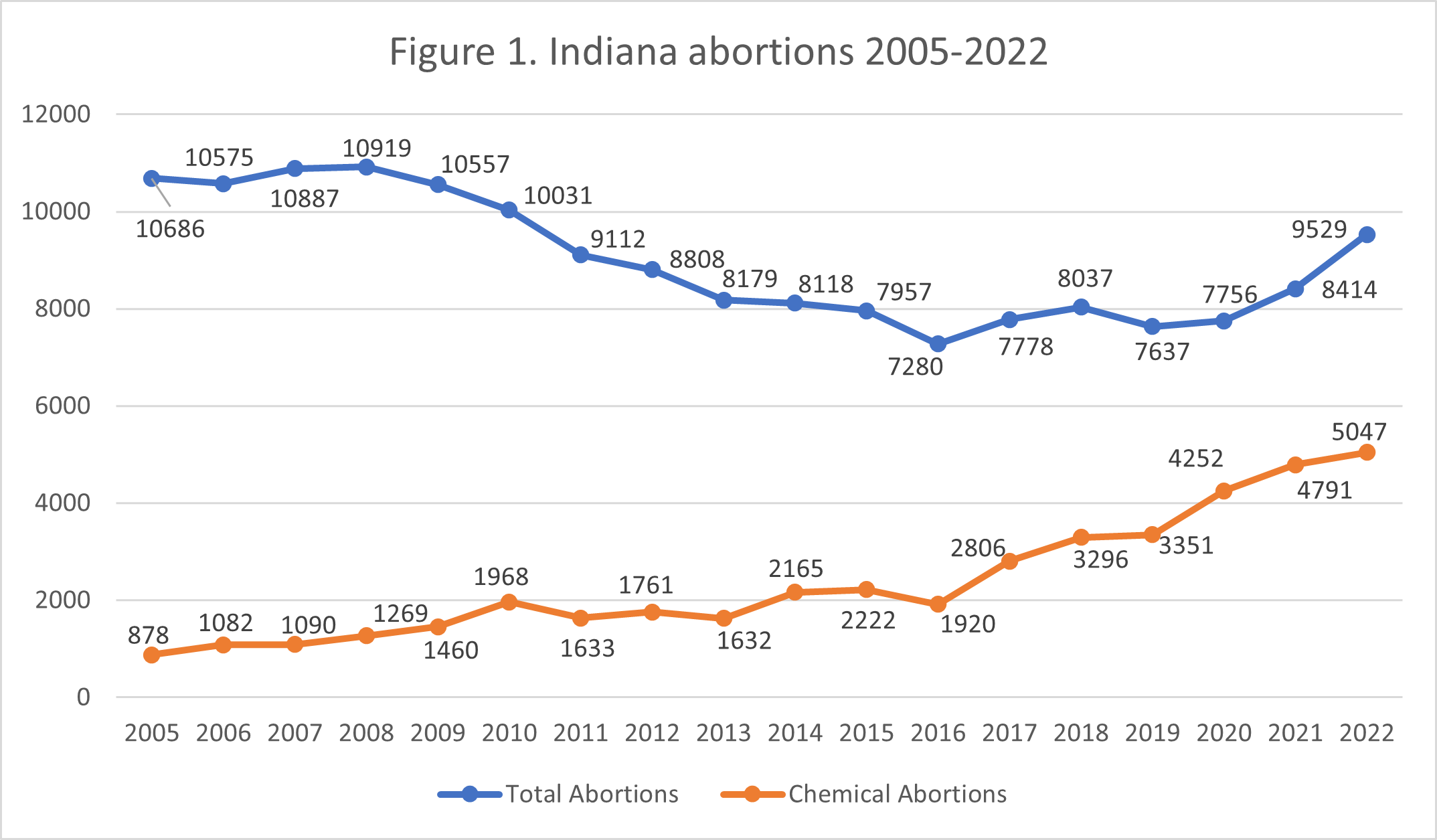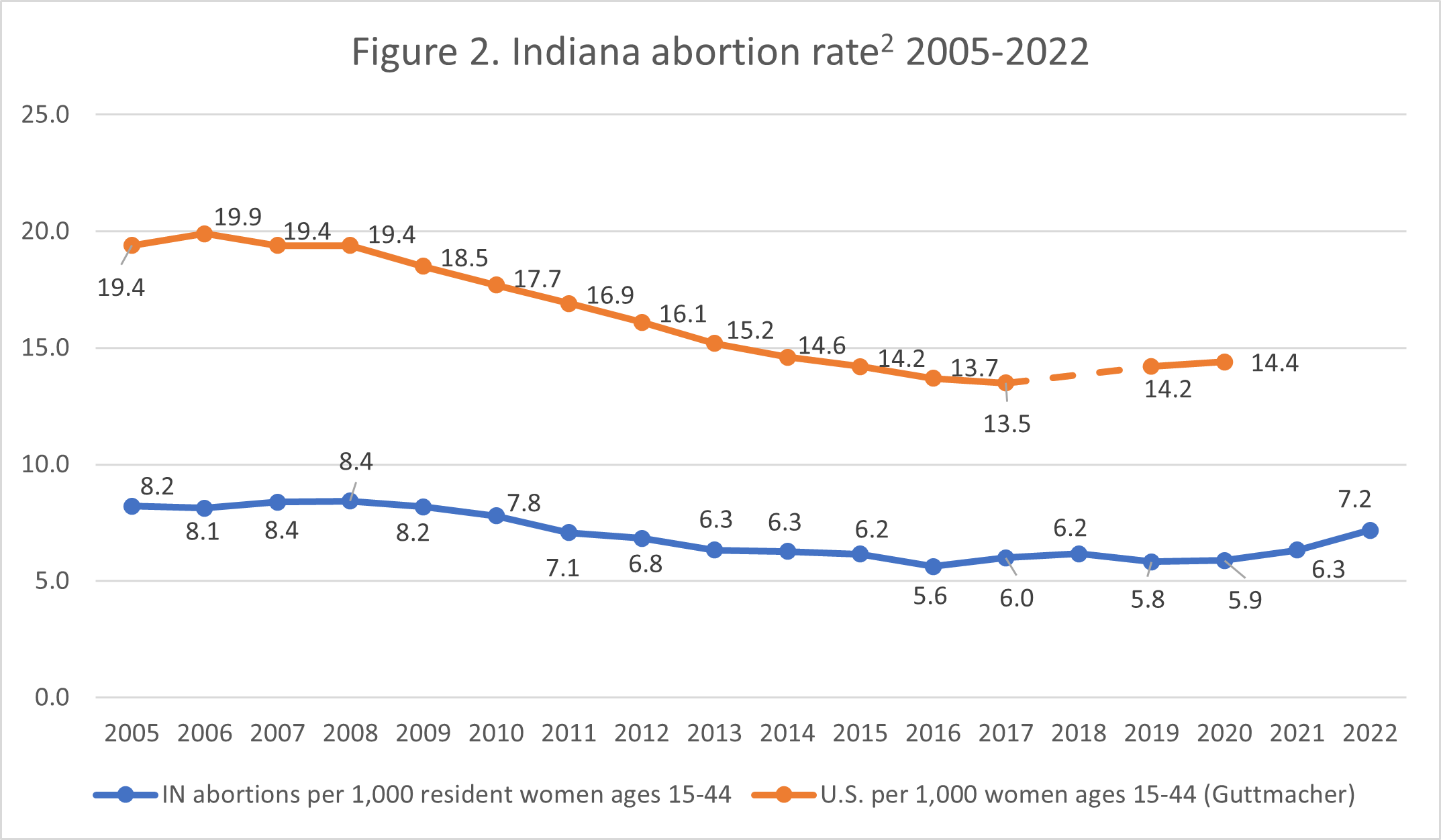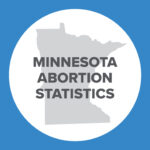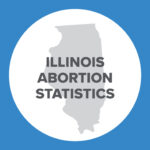Abortion Reporting: Indiana (2022)
Indiana’s 2022 abortion report was published in June 2023, revealing that abortions increased from 2021 in the Hoosier State.
Statistics and Changes in Indiana Abortions, 2021-2022

Abortion Totals and Trends
In 2022, there were 9,529 abortions reported in Indiana, up 13 percent from the previous year. Chemical abortions rose by five percent, composing over half of all Indiana abortions (53 percent) in 2022 (Fig. 1). The Charlotte Lozier Institute (CLI) estimates that Indiana’s 2022 abortion rate was 7.2 abortions per 1,000 women ages 15 to 44, an increase of 13 percent from 2021 (Fig. 2). As of August 2023, 14 states had released 2022 abortion statistics, of which 10 reported that abortions had increased from 2021.
State Report Summary
In 2022, 81 percent of the abortions reported in Indiana were performed on state residents, down from 94 percent the previous year. Nineteen percent were obtained by nonresident women, including 10 percent on women from Kentucky, nearly four times the number of Kentucky women who obtained abortions in Indiana in 2021. Abortions on Ohio women jumped by more than 1,400 percent, and abortions on Tennessee women increased nearly 830 percent. One potential explanation for these major increases is that these states had more protective pro-life laws than Indiana following the Dobbs decision for either part of 2022 or the remainder of 2022 from July to December.
Over half the abortions (58 percent) were on women in their twenties, with 31 percent performed on women ages 20 to 24 and 28 percent on women ages 25 to 29. Twenty-nine percent were performed on women in their thirties. Four percent of Indiana abortions were on women ages 40 and older, and nine percent were on girls under the age of 20.
Forty-eight percent of Indiana abortions were performed on white women, 36 percent on black women, and three percent on Asian women. American Indian/Alaska Native women constituted 0.3 percent of the total, while 0.2 percent were performed on Pacific Islander women. Six percent of Indiana abortions were performed on women of other races, two percent on women of multiple races, and four percent on women of an unknown race. The black abortion rate (22.3 abortions per 1,000 women ages 15-44) was more than five times the white abortion rate (4.2). Eighty-eight percent of Indiana abortions were obtained by non-Hispanic women while 10 percent were obtained by Hispanic women. Two percent of the abortions performed in the state were on women of unknown ethnicity.
In 2022, nine abortions were performed in Indiana on women with no formal education and 10 percent women who had not completed high school. Thirty-six percent of Indiana abortions were performed on women with a high school diploma or its equivalent, and 20 percent were obtained by women who had completed some college but did not have a degree. Nearly a quarter of Indiana abortions were performed on women with a college degree. Level of education was unknown for 10 percent of the abortions.
Eighty-seven percent of the abortions reported in Indiana were obtained by unmarried women and 13 percent by married women. Thirty-eight percent of Indiana abortions were performed on women with no living children. Just under a quarter (24 percent) were on women with one child, and 37 percent on women with two or more children. Sixty-five percent of the abortions were procured by women with no previous abortions, compared to 22 percent by women with one prior abortion and 12 percent by women with more than one. Eighteen percent of the abortions were performed on women who had previously had a miscarriage.
Over half the abortions reported in Indiana, 53 percent, were chemical. Forty-seven percent were surgical, a category that includes suction curettage, menstrual aspiration, dilation and evacuation, and other procedures, although the report did not include the percentage of abortions performed by each procedure type. Sixty-one women experienced an unsuccessful abortion upon first attempt and had to return to the abortion clinic for an additional procedure.
Sixty-seven percent of Indiana abortions occurred at eight weeks gestation or earlier. Thirty-two percent were performed between nine and 13 weeks, while relatively few abortions were performed after 13 weeks. There were 75 abortions between 14 and 20 weeks (0.8 percent) and 29 abortions performed at 21 weeks gestation or later.
Half of Indiana abortions (50 percent) were performed in Planned Parenthood’s four Indiana abortion centers, with a quarter of the state’s total abortions being performed at Planned Parenthood’s Georgetown Clinic located in Indianapolis. Just under one-third of Indiana abortions (31 percent) were performed in The Women’s Medical Center of Indianapolis, 14 percent occurred at Clinic for Women, and three percent were reported by Whole Woman’s Health of South Bend. One percent of the abortions occurred in hospitals. The month of July had the most abortions (1,182) and October had the fewest (447).
Changes to Indiana’s Abortion Complication Reporting Laws
In October 2021, a new abortion complication reporting law (SB 340), originally passed in 2018, was allowed to go into effect following a federal appeals court’s decision. This law requires the Department of Health to publish a separate report summarizing abortion complication data. Complications reported before the law went into effect on October 28, 2021, were included in the state’s 2021 annual abortion report, and complications reported after were collated and published in a separate report.
The 2022 complications report was released simultaneously with the state’s 2023 annual abortion report at the end of June 2023. In 2022, 100 complication reports were filed with information on 121 total complications (patients can have more than one complication listed on a report). Seventy-two of the 100 complication reports were associated with chemical abortions, including two resulting from mail-order abortions. Twenty-six involved surgical abortions, and two involved an unknown method.
The most frequently reported complication was incomplete abortion (retained tissue), with 35 cases reported. There were 31 failed abortions, 10 cases of vaginal bleeding, and five cases each of uterine perforation and infection. Four cases of cervical laceration were reported and there was one case of psychological complications. Tragically, there was one death reported as a complication from an abortion. There were 27 other, uncategorized complications and two complications of unknown type.
The new complications report also details the type of treatment that women received when they sought medical help for their abortion complications Two reports indicated that women were admitted to the hospital, 58 reports indicated that surgical intervention was needed, four reported that blood transfusions were performed, and 16 reports indicated that medication was used to treat the complication(s). Six reports noted that other treatment was used, and 30 reports noted that an unknown treatment was utilized.
The newly improved report also lists the number of complications by race, ethnicity, county of residence, and the facility where the patient presented with complications. It further lists the names of the clinics that treated women with abortion-related complications, even if those abortions were performed out of state.
Other Legislative Changes
Indiana’s abortion complications reporting law was not the only reporting law that was amended in the state. SB1, passed in August 2022, not only prohibited all abortions except in cases where the mother’s life or physical health was endangered and in cases of rape, incest, or when the unborn child is diagnosed with a “lethal fetal anomaly,” it also amended the state’s abortion reporting statute. The statute now requires that abortion reports, collected by the state’s Department of Health, be published quarterly, not annually. The first quarterly state report was published in June 2023 and covered Indiana abortions performed from January-March 2023. CLI will publish an analysis of Indiana’s 2023 abortion statistics after data from all four quarters are published.
SB1was blocked due to a lawsuit in September 2022, but in June 2023, the Indiana Supreme Court ruled that the state constitution does not confer a right to abortion, vindicating the law. Another lawsuit brought against SB1 is seeking to challenge the law on grounds of religious freedom, though SB1 was expected to go into effect on August 1. However,, on July 31st the ACLU of Indiana petitioned the Supreme Court of Indiana to continue the injunction on SB1 as it considers challenging the law. The hold on the law remains and SB1 is not in effect.
State Ranking
In 2016, CLI evaluated abortion reporting across the 50 states, New York City, and the District of Columbia, and Indiana’s reporting was ranked 5th best. Since then, Indiana improved the timeliness with which it publishes its reports and has strengthened its complications reporting law. Indiana could further improve its abortion statistics by reporting the types of surgical procedures used in the state and providing the reasons why women sought abortions.


- Statistics on abortion complications reported here represent a minimal number of deaths and complications, as this data is collected in a non-systematic and non-verifiable way. As such, this data cannot be used to calculate either an accurate abortion mortality rate or an accurate abortion complication rate for the state.
- National rates were estimates by the Guttmacher Institute. Indiana rates were calculated by CLI using the following formula: (total number of abortions performed in Indiana ÷ number of resident women ages 15-44) x 1,000. Rates may differ slightly from previous CLI articles due to revised population estimates. Population estimates were obtained from the CDC WONDER database. Estimates for 2005-2009 are intercensal estimates of the July 1 resident population. Estimates for 2010-2019 are Vintage 2020 postcensal estimates of the July 1 resident population. Estimates for 2020-2022 are Vintage 2021 postcensal estimates of the July 1 resident population as the CDC has not released 2022 population estimates yet. Estimates were produced by the U.S. Census Bureau and the National Center for Health Statistics.



























